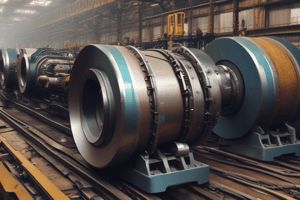Podcast
Questions and Answers
Which process is preferred when the strength of the part is important?
Which process is preferred when the strength of the part is important?
- Casting
- Rolling
- Machining
- Forging (correct)
What is the result of cold working on steel?
What is the result of cold working on steel?
- An increase in strength and hardness, and a decrease in ductility (correct)
- A decrease in density and an increase in coarse grains
- An increase in ductility and a decrease in strength
- A change in the color of the steel
What is the primary goal of tempering?
What is the primary goal of tempering?
- To reduce the residual stresses and increase ductility (correct)
- To facilitate machining and cold shaping
- To produce a special structure
- To increase the hardness of the steel
What is the result of quenching on the ductility and toughness of the steel?
What is the result of quenching on the ductility and toughness of the steel?
What is the purpose of the first stage of rolling?
What is the purpose of the first stage of rolling?
What is the primary difference between normalizing and annealing?
What is the primary difference between normalizing and annealing?
What is the term for the intermediate shape of the steel when its cross section is square or rectangular?
What is the term for the intermediate shape of the steel when its cross section is square or rectangular?
What is the consequence of overworking, whether hot or cold?
What is the consequence of overworking, whether hot or cold?
What is the result of forging on the grain size of the metal?
What is the result of forging on the grain size of the metal?
What is the purpose of heating to a lower temperature range in tempering?
What is the purpose of heating to a lower temperature range in tempering?
Why is cold working preferred for certain applications?
Why is cold working preferred for certain applications?
What is the purpose of turning the ingot 90° during the second stage of rolling?
What is the purpose of turning the ingot 90° during the second stage of rolling?
What is the primary difference between rolling and extrusion?
What is the primary difference between rolling and extrusion?
Which process can produce a product with a cross section of nearly 2 ft?
Which process can produce a product with a cross section of nearly 2 ft?
What is the primary advantage of cold drawing over hot rolling?
What is the primary advantage of cold drawing over hot rolling?
What is the primary difference between forging and rolling?
What is the primary difference between forging and rolling?
What is the primary purpose of forging?
What is the primary purpose of forging?
What is the common feature of rolling and extrusion?
What is the common feature of rolling and extrusion?
Flashcards are hidden until you start studying




